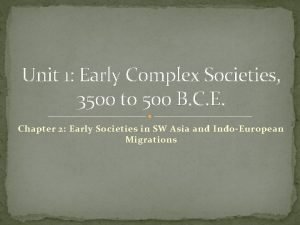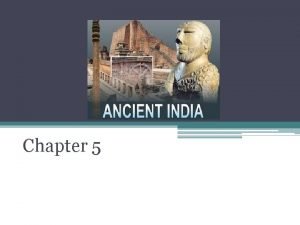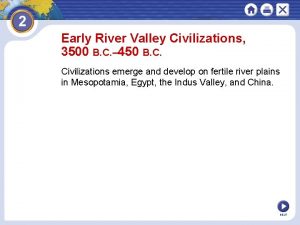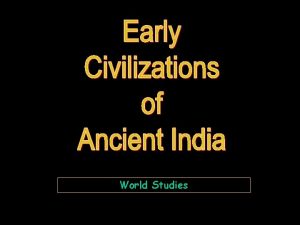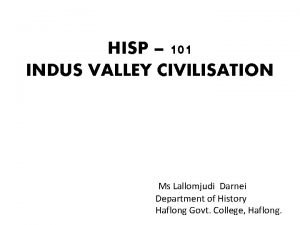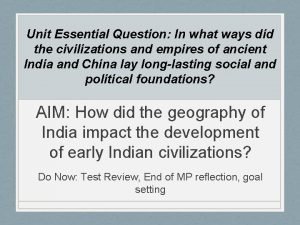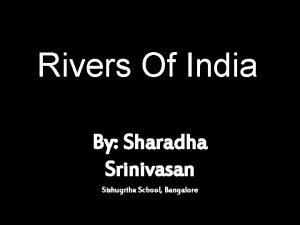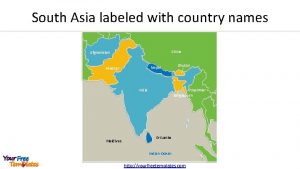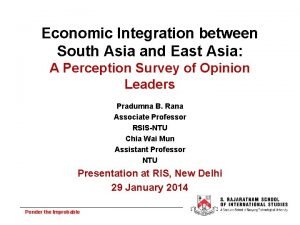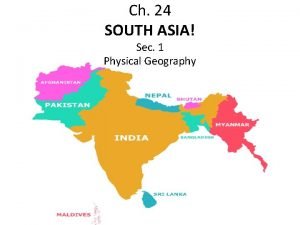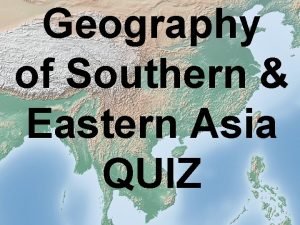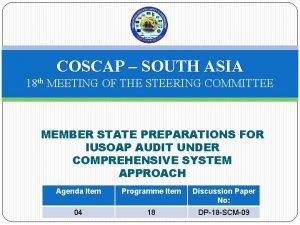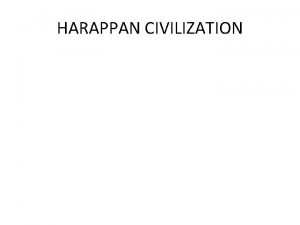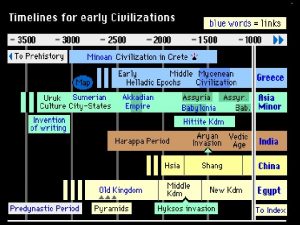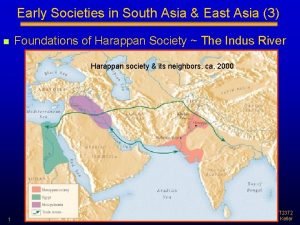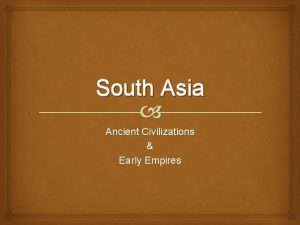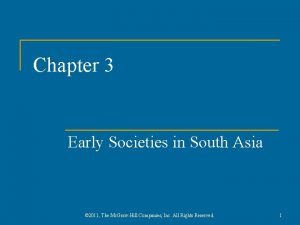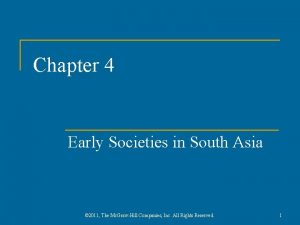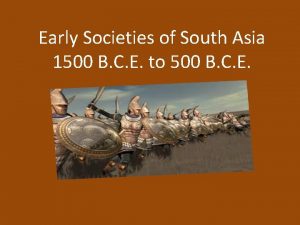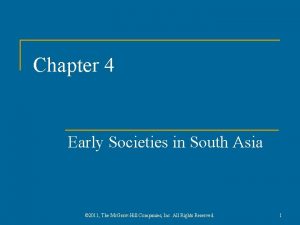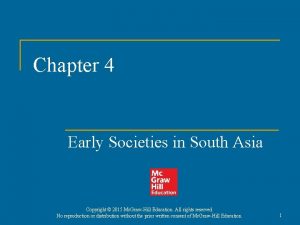Ch 4 EARLY SOCIETIES IN SOUTH ASIA Harappan



















- Slides: 19

Ch. 4 EARLY SOCIETIES IN SOUTH ASIA

Harappan Society

Foundations of Harappan Society The Indus River • Less predictable • Agriculture possible In N. India • Wheat & barley • Cotton • Agricultural surplus Led to pop. Growth to Cities & spec. labor Political Organization • No evidence of Harappan political System • Economic & Political centers for Their own regions Harappa & Mohenjo-Daro Specialized Labor & Trade • City walls • Fortified citadel • Granary • Political authority Centers • Collection/redistribution Of taxes in grain • Marketplaces • Temples • Residential cities • Streets • Standardization: weights, Measures, brick size, Architectural design • Trade: domestic & foreign • Export: pottery, Tools , decorative Items • Import: gold, silver, Copper, lead, gems • Traded with: Persia, Mesopotamia, Hindu Kush

DISCUSSION QUESTIONS � 1. What do you think standardization infers about Harappan society?

Harappan Society and Culture Social Distinctions • No palaces, tombs • Rulers ruled from A citadel • Rich & poor had Different lifestyles • From 1 bedroom Tenements to 2/3 Story houses w/several Rooms, courtyards • Rich had wells and brick ovens • Private bathrooms/ Showers • Water/sewer systems very Advanced • Representational art • Gold, copper & Bronze experts Fertility Cults • Concern for Fertility • Venerated gods/goddesses Associated w/creation & Procreation • Animals & trees sacred due To association of vital forces • Similarities w/Harappan & Hindu Deities. Harappan Decline • 1900 bce decline • Theory: ecological Degradation (deforest For cultivation & firewo

DISCUSSION QUESTIONS � 2. Why do you think Harappan society was able to have such technological advancements (ex. Brick ovens, sewer systems)? � 3. Why do you think Harappans maintained a closeness with the idea of fertility cults?

The Indo-European Migrations and Early Aryan In

The Aryans and India The Vedas The Early Aryans • • limited agriculture pastoral economy (sheep, goats) • Horses a commodity and imported • Horse used to facilitate transportation and chariots • Cattle=wealth • • • Songs and poems. Preservation through memorization and oral transmission Collection of hymns, songs, prayers & rituals honored Aryan Gods Rig Veda-1028 hymns addressed to Aryan gods priestly perspective on affairs Veda means “wisdom”/ “knowledge”; needed to carry out priestly functions The Vedic Age • • Dravidians and others living in India. indigenous people dasas “enemies”/“subject people”. Indra=Aryan war god Intermittent conflicts w/Dravidians Aryans fought amongst themselves No state or common gov’t, but chiefdoms. Rajas=chiefdom leaders

The Aryans and India Cont’d Aryan Migrations in India • Settled in Punjab • Est. communities through east subcontinent • Make iron tools (cultivate, food surplus Support large communities • agricultural communities • Cultivated rice Changing Political Organizations • well defined social order • Hereditary distinctions between individuals & groups according to their roles & occupation in society • Foundation of caste system • Caste =social class of heredity, usually unchangeable status

DISCUSSION QUESTIONS � 4. Compare and Contrast Dravidians and Aryans.

Origins of the Caste System Caste & Varna • Developed slowly And gradually • Interactions w/ Dravidians led to refine social distinctions • Varna=color • Social distinctions Arose partly from Complexion • Aryans & Dravidians mixed, mingled, intermarried, became difficult to distinguish • Social distinction on Ancestry Social Distinctions In the Late Vedic Age • • • 4 main varnas: 1)brahmins (priests), 2)kshatriyas (warriors &aristocrats), 3)vaishyas (cultivators, artisans &merchants), 4) sudras (landless peasants & serfs) Untouchables= dirty or unpleasant tasks Varnas as a part of the creation of the early days Subcastes & Jati • Elaborate social Classification • jati=people working at the same or similar tasks in a given area belong to the same subcaste • Offspring joined Occupation & Membership • Jati members Cared for each other • rules and specific behavior • Breaking jati rules could result in expulsion from the Caste & Social Mobility • Accommodated social change • Higher castes members Could moved down socially • Based more on groups than Individuals • Social mobility eased tensions • Allowance of foreigners in The system

DISCUSSION QUESTIONS � 5. Do you think the varna would have developed into the caste system had the Aryans and Dravidians never interacted? � 6. Why do you think that the jati had to move up as a group and could not move up individually?

Development of a Patriarchal Society The Lawbook of Manu • • Women under authority of man Law Book dealt w/moral behavior & social relationships Respect & honor women, but women subject to guidance of man Woman’s duty according to the book was to bear children and maintain their homes. Sati • Widows voluntarily throws themselves on the funeral pyre of deceased husband to join him in death b. this ritual esp. for socially prominent women to show devotion to husbands

DISCUSSION QUESTIONS � 7. Why do you think that sati was only for prominent women?

Religion in the Vedic Age

Aryan Religion Aryan Gods Spirituality Ritual Sacrifices • • Indra=war deity, chief deity • Associated with weather, rain to water the crops • Other deities, but Indra represents instability in early Vedic Age • Varuna-sky god, oversaw behavior of mortal and preserved cosmic order • • • Rituals more important than ethical concerns Believed gods came down to earth to join them in rituals Felt that sacrifice& pleasing gods would lead to military success, large families, long life & abundant herds • Tired of sacrificial rituals (no real communication w/gods) Inspired by Dravidian connections w/natural spirits Believed human souls took on new physical forms after death (transmigration and reincarnation) idea that you could come back as a plant or animal or associate w/another body through a new birth

DISCUSSION QUESTIONS � 8. Why do you think that the Aryan religion shifted from ritual sacrifice to more spirituality?

Blending of Aryan and Dravidian Values The Upanishads Brahman The Universal Soul • • a body of work (800 -400 bce) that refers to the practice of disciples gathering before a sage for discussion of religious issues • • Appearances are deceiving, we are not separate autonomous creatures We are a part of a larger cosmic order a universal soul, Brahman is eternal, unchanging, permanent foundations for all things Individuals souls were born into the physical world several times Highest goal of the soul was to escape the cycle of birth & rebirth enter into Teachings of Upanishads • • • Samsara- souls go to the World of the fathers, return to earth in new incarnation Karma-live virtuous lives , fulfill duties expect rebirth more honorable existence, Did not fulfill duties, rebirth would be a harsher existence Moskha-deep, dreamless sleep, liberation from physical incarnation Yoga helps to concentrate on Brahman and relationship w/the soul Religious & Vedic Society • • • Samsara and karma explain why individual were born into social groups Upanishads discourage all manner of vice that indicated attachment to the material world Encourage personal integrity and respect for all living things

DISCUSSION QUESTIONS � 9. Why do you think Upanishads encouraged a detachment from material things?
 Monotheism
Monotheism Image search
Image search Selyong harappan
Selyong harappan Harappan civilization
Harappan civilization Introduction of indus valley civilization
Introduction of indus valley civilization Drainage system in harappan civilization
Drainage system in harappan civilization Harappan pottery
Harappan pottery Indus valley civilization conclusion
Indus valley civilization conclusion Harappa map
Harappa map Conclusion of indus valley civilization
Conclusion of indus valley civilization Economy indus valley civilization
Economy indus valley civilization Indus valley civilization education
Indus valley civilization education South asia map and capitals
South asia map and capitals Chapter 25 section 3 nepal and bhutan
Chapter 25 section 3 nepal and bhutan South asia
South asia South asia physical features map
South asia physical features map South asia unit test
South asia unit test Arya south asia 46m series 14msinghtechcrunch
Arya south asia 46m series 14msinghtechcrunch South asia physical features
South asia physical features Coscap south asia
Coscap south asia
